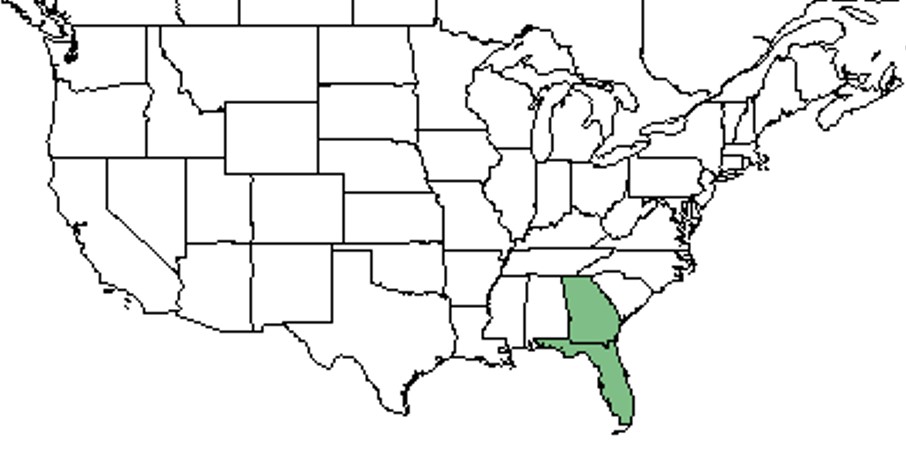Difference between revisions of "Liatris laevigata"
KatieMccoy (talk | contribs) |
KatieMccoy (talk | contribs) (→Description) |
||
| Line 27: | Line 27: | ||
<!-- Basic life history facts such as annual/perrenial, monoecious/dioecious, root morphology, seed type, etc. --> | <!-- Basic life history facts such as annual/perrenial, monoecious/dioecious, root morphology, seed type, etc. --> | ||
A description of ''Liatris laevigata'' is provided in [http://www.efloras.org/florataxon.aspx?flora_id=1&taxon_id=250067105 The Flora of North America]. | A description of ''Liatris laevigata'' is provided in [http://www.efloras.org/florataxon.aspx?flora_id=1&taxon_id=250067105 The Flora of North America]. | ||
| + | |||
| + | ''L. laevigata'' is a perennial species that consist of a globose corm, glabrous stem, basal and proximal cauline leaves<ref name="swbiodiversity"/>. The inflorescence consists of a scape with reduced leaves and many purple flower heads (Herndon 1987). | ||
==Distribution== | ==Distribution== | ||
Revision as of 17:52, 13 January 2016
| Liatris laevigata | |
|---|---|
Error creating thumbnail: Unable to save thumbnail to destination
| |
| Scientific classification | |
| Kingdom: | Plantae |
| Division: | Magnoliophyta - Flowering plants |
| Class: | Magnoliopsida – Dicotyledons |
| Order: | Asterales |
| Family: | Asteraceae ⁄ Compositae |
| Genus: | Liatris |
| Species: | L. laevigata |
| Binomial name | |
| Liatris laevigata (Nutt.) Small | |

| |
| Natural range of Liatris laevigata from USDA NRCS Plants Database. | |
Common name: Shortleaf blazing star
Synonym names: Liatris tenuifolia var. quadriflora Chapm.; Liatris tenuifolia var. laevigata (Nutt.) B.L. Rob.
Contents
Taxonomic notes
Sometimes L. laevigata is classified as a variety of L. tenuifolia, however, they have distinct characteristics. L. laevigata can be distinguishable from L. tenuifolia by having wider and coarser leaves[1].
Description
A description of Liatris laevigata is provided in The Flora of North America.
L. laevigata is a perennial species that consist of a globose corm, glabrous stem, basal and proximal cauline leaves[2]. The inflorescence consists of a scape with reduced leaves and many purple flower heads (Herndon 1987).
Distribution
Restricted to peninsular Florida and adjacent Georgia [2].
Ecology
Habitat
Habitats are well-drained sandy soils such as longleaf pine-saw palmetto flats; ecotones between longleaf pine turkey oak sand ridges and pine flatwoods; scrub oak-wiregrass ridges; Pinus clausa/Ceratiola scrubs; Quercus laurifolia hammocks; and pine flatwoods on limerock. It has occurred in disturbed areas such as roadsides, sandy fallow fields, and bulldozed clearings of pine flatwoods. Associated species include Liatris pauciflora, Aristida, Sorghastrum, Carphephorus corymbosus, Pinus clausa, Serenoa repens, Carya florida, Quercus myrtifolia, Quercus geminata, Osmanthus megacarpus, Prunus geniculata, Bumelia, Ceranthera, Polygonella, and Penstemon (FSU Herbarium).
Phenology
Flowers and fruits August through December (FSU Herbarium).
Seed dispersal
Seed bank and germination
Fire ecology
Pollination
Use by animals
Diseases and parasites
Conservation and Management
Cultivation and restoration
Photo Gallery
References and notes
Florida State University Robert K. Godfrey Herbarium database. URL: http://herbarium.bio.fsu.edu. Last accessed: October 2015. Collectors: Loran C. Anderson, Jane Brockmann, W.C. Brumbach, Richard Carter, Steven P. Christman, Andre F. Clewell, George R. Cooley, David K. Dorman, Richard J. Eaton, J. Ferborgh, Robert K. Godfrey, S.C. Hood, Beverly Judd, Walter S. Judd, Gary R. Knight, Robert Kral, Olga Lakela, S.W. Leonard, Tin Myint, Jackie Patman, R.E. Perdue Jr., Kent D. Perkins, James D. Ray Jr., D.B. Ward. States and Counties: Florida: Brevard, Citrus, Collier, Dade, Duval, Hardee, Hernando, Highlands, Hillsborough, Jackson, Lake, Lee, Levy, Marion, Monroe, Nassau, Osceola, Pinellas, Polk, Putnam, St. Johns, Suwannee, Taylor. Compiled by Tall Timbers Research Station and Land Conservancy.